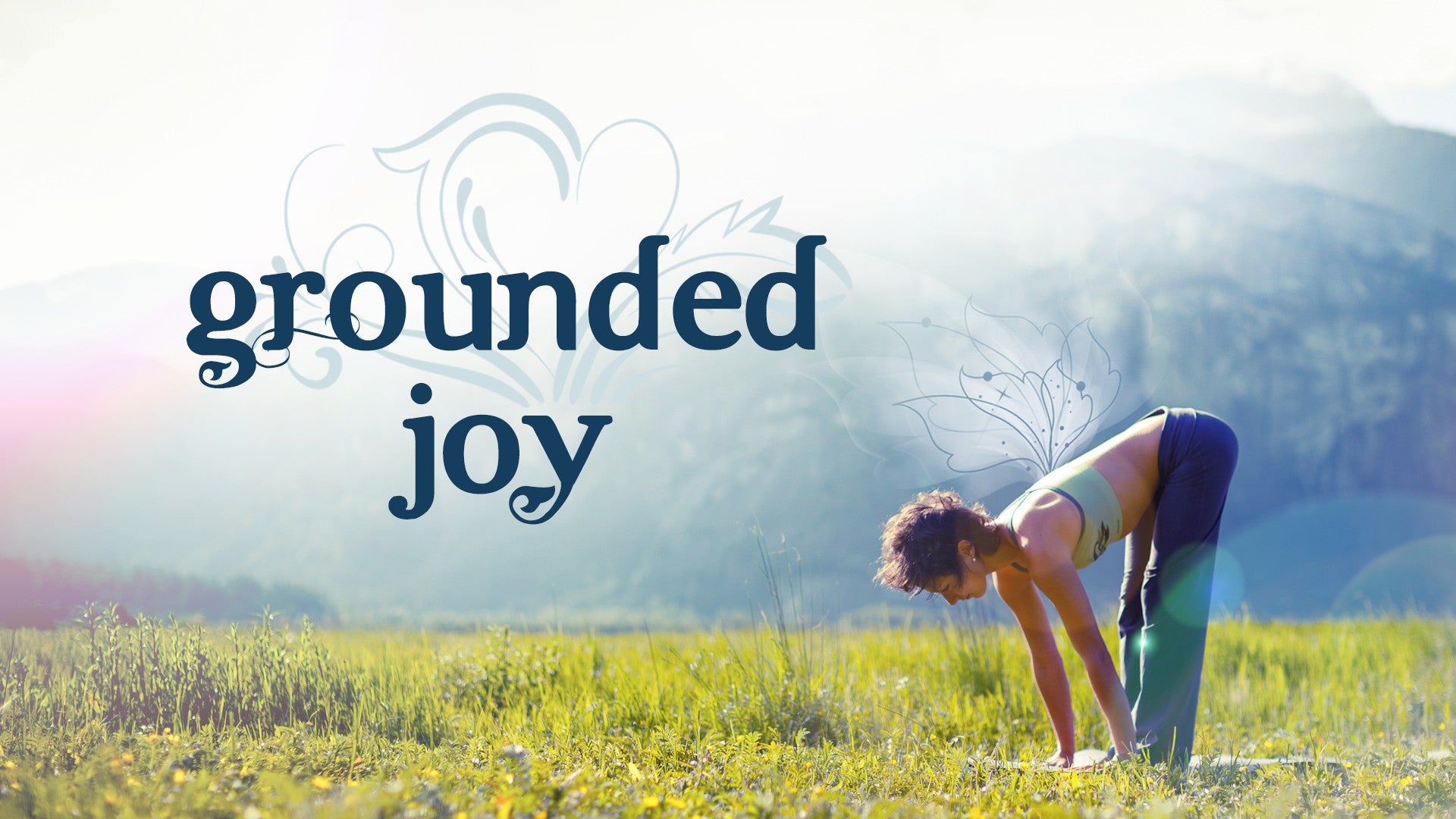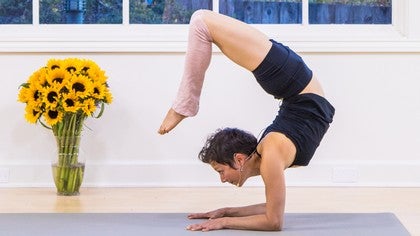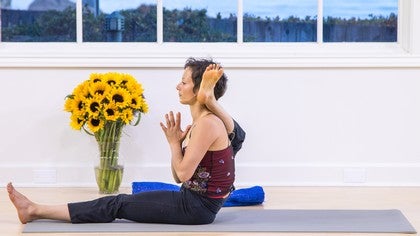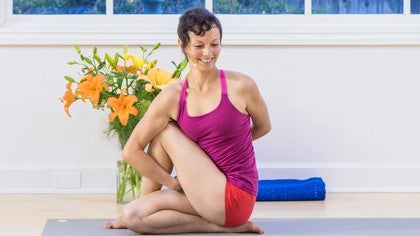Description
About This Video
Transcript
Read Full Transcript
Hi. Thanks for showing up here. This practice is gonna look at, work with, back bending. If you have a dropback practice and a headstand practice, you're gonna love this practice. If you don't yet, but you're excited about those things, I would encourage you to join in.
And watching is always a great way to learn. So maybe you just watch at first and start to add on little pieces. Let's come to the top of the mat. Big toes touch, spread your toes away from the big toe, center your heel. Hands come in front of the heart.
As you press your fingertips together and feel flex in all of your fingers, and arch in all of your fingers, feel the center point of your palms. And feel the warmth coming from one hand to the other. Left and the right side of the body in relationship. And evenness through the two sides. Find a radiant breath.
Something that stokes you, but also relaxes you. See if with the breath you can hold those two needs for stability and support and also adventure. Exhale your hands down by your sides. Inhale your arms up, slide through your shoulders. Exhale your arms down by your sides.
Imagine you're liquid inside, inhale, take your arms up. Which you are, exhale your hands back down by your sides. Inhale your arms up. Exhale fold forwards. Inhale, lengthen.
Exhale, dog pose. Land and your legs really shock absorb. Inhale. Plank pose. Exhale, chaturanga or onto the belly.
Knees down, tops of the feet down, press even weight in your two legs. Tailbone down, sacrum scoops in and up. Belly stretches, upward dog. Exhale, round back, low back, mid back, upper back. Downward dog.
Breathe. Shift a little more weight into your right and your left foot. Feel the diagonal line through your body. And then switch, shift more weight into your left hand and your right foot. See if you can pinpoint the diagonal line through your belly, and press into all four corners.
And see if you can notice where that diagonal line crisscrosses. Let your head go. Soften your knees, step or hop forwards. Exhale, fold. Inhale, come all the way up.
Exhale. Again, surya namaskar, inhale. Exhale fold. Inhale lengthen. Exhale, hands down, shift into the fingertips, come onto your toe pads.
If it's okay on your wrists, move your shoulders over your finger pads, lift one leg up into the core. Lift the other leg up into the core. Maybe both. Downward dog. Inhale, plank pose, round, and then lengthen, heels to skull, shift forwards, exhale, chaturanga.
Wide collarbones, inhale, make space in the upper chest. And in between the shoulder blades, exhale, downward dog. Breathe. Enliven your feet and your hands. Embody your feet and your hands.
See if you can strengthen, widen, and dome open your hands and your feet, and then relax your spine. Bend your knees, step, hop or float forwards. Hips over the shoulders, maybe over the fingertip line. Exhale, fold. Inhale, come up.
Exhale. Inhale. And exhale. Inhale, lengthen. Exhale, hands plant.
Maybe. Handstand it up. One legs or two legs at a time. One leg is a little softer, chaturanga, upward dog. Downward dog, round open the spine, balloon your back muscles and breathe.
Feel a lifting of your armpits, a lengthening of the sides of the body, a softening of the backs of the knees. One more breath, and if you like to play up in a handstand, bend your knees, see if your hips can come over your shoulders or even your fingertip line. And come down slowly. Inhale, come all the way up, release tension. Exhale.
Step your feet hip distance apart. Inhale your arms up. Exhale, fold forwards, take your big toes. Inhale, come up halfway. Exhale, fold paschimottanasana.
Or sorry, padangusthasana is this one. It's actually paschimottanasana in a different, in a different orientation, but. Inhale, come up halfway, exhale, ragdoll your arms. Inhale, come all the way up. Exhale.
Arms up. You are liquid. Exhale, fold, lean into your heels, pick up your toes, both hands under at the same time. Inhale lengthen, exhale fold. Spread your sit bones.
Encourage your pubic bone to move skyward without overstretching the backs of your knees. Unplug your hands, exhale, ragdoll them. Inhale, come all the way up. Exhale. Feet together, little bit of a tighter forward fold.
Inhale, arms up. Exhale, fold. Take your hands behind your calves. Prayer position, or hold onto your calves here. And lengthen your inner line of your legs.
Press your big toes down, lengthen your abductor muscles into your pelvic floor. Root down your pinkie toes, and deepen your fold. Sweep your arms out to the side. Without touching the floor, come all the way up. Exhale.
Arms up, moving toward urdhva dhanurasana. Exhale, fold forwards. Inhale, lengthen. Exhale, dog pose. Inhale, plank pose.
Look forwards a little bit, lengthen, really wide collarbones, soft armpits, chaturanga, inhale, upward dog. Exhale, downward dog. So I'm gonna show you the first way of getting into urdhva dhanurasana without doing the headstand position. Bend your knees, hop, squat. Sink down, maybe your feet need to be a little bit wider apart or turned out on an angle.
I like to do that slowly because it's a bit easier on my knees. Drop your hips down, take your feet forwards, heels heavy, knees a little bit lifted. Curve the spine, belly back to the spine. Roll down. So just to warm up, let's move towards setu bandhasana, the bridge pose.
Feet plant, press into your feet, lean your feet into the Earth. Move your tailbone towards the backs of the knees. Roll up, one vertebra at a time. You can roll your shoulders a little bit under you, and if you come up onto your toe pads, you may be able to clasp under your hips. And then see if you can drop your heels here.
Lengthen. As you press into your toes, your chest will move towards your chin. As you press into your heels, your hips will move a little bit higher. Let your chin be a little bit soft. And instead of jamming it down towards your chest, lift it a little bit.
Move your arms out to the sides. Maybe you need to come up onto your heels to do that, exhale, roll down one vertebra at a time. So this is the play, you can roll back into like a little half plow onto the shoulders, and roll all the way into a forward fold. Then inhale, come up. So any of these postures you can enter that way.
I'll show you a different way now. Inhale the arms up. For urdhva dhanurasana, exhale fold. Inhale, lengthen. Dog pose.
Inhale, plank pose, soften a little bit the back of the chest. Elbows in, exhale, chaturanga. Soft wide armpits, inhale. Urdhva, exhale. Downward-facing dog.
From downward-facing dog, walk to the back of your mat. You can come down onto your knees, but a neat way of doing this to come into the headstand position is to interlock, find your interlock, elbows in. Drop your forearms, if you have enough room in the back of the legs, let your head come down. Make sure you can you see elbows in your peripheral vision and your shoulders are up. Then come up.
So now what we're gonna do is drop into viparita dandasana. So maybe you've done this before, but the start is to come into a little bit of a back bend in this position, so the tailbone moves up. So you're decompressing your lower back. Little bit of a back bend comes into the chest. The space in between the shoulder blades moves in towards the heart.
You can bend the knees and separate, bend the legs and separate the knees a bit. Let the back bend come up into your chest, and the space in between your shoulder blades should sort of hollow towards your heart. So the back bend comes up into the chest, roll towards the hairline. You're quite strong in your arms here. And, drop.
Find the edges of your mat, and then walk your feet in. So now we're coming into viparita dandasana. You can straighten your legs here, or you can keep them a little bit bent. Elbows pinned down. Shoulder blades away from the ears.
So walk your feet in here. Come onto your hands, press into your hands, tuck your chin and roll down. We're gonna move into urdhva dhanurasana. So from your back, invert your hands, elbows move in, knees connect towards each other. And one vertebra at a time, tailbone moves towards the backs of the knees quite strongly.
But then with that tailbone tuck, as you come up onto the top of the head, start to move your sacrum in and up. Lengthen your belly muscles, and come up. So super long lower back, bringing the back bend into the upper chest. So to come up from here, you can either come down, do the half plow, roll towards a forward fold, or maybe walk your feet a little closer, and if you have a coming up practice from urdhva dhanurasana, root down into your feet, do a little bit of shifting the weight. When you shift the weight into your feet, come up.
And walk forwards. So falling out of things is underrated. Sometimes, if you're a little bit softer, you fall outta something, you get back into it, no big deal. Being rigid and trying to catch yourself sometimes can create a lotta compression in the body. Exhale your hands down.
Inhale. Exhale. Inhale. Exhale. Inhale, plank pose.
Exhale. Upward dog, long side body. Downward dog. Walk back. Widen the feet, or maybe come to the knees.
Find your headstand position. This is a wonderful way to open up the back line. You should be able to see your elbows. Pubic bone up. Shirshasana.
Back bend a bit, open your knees, bend the legs, tailbone up, sacrum in and towards your low back. Roll onto your hairline. It doesn't need to be a big bend. You can drop here. Once you find the floor, walk your feet a little bit wide so you can feel the edges of the mat.
I learned this from my teacher Julia Irwin, and so when you come in, you're not super crooked. You can feel where your feet are, so you're not sideways. And then just from here, we're gonna come onto the back of the skull a little bit, find the hands. Tailbone towards the backs of the knees, try not to squeeze your bum together, your bum muscles together, but move them down towards your hamstrings and come up. So we're gonna walk the feet a little closer together, and bring the left knee in towards the chest.
If it feels okay to be there and you feel fairly stable, eka pada dhanurasana. And down, so you can lengthen that leg, stabilize, it might be way harder on one side, depending on what's going in your body. Knee in, wrapping the back muscles around to the front. Exhale. For me to come up, I have to come make the back bend a little bit shorter, so that I can really root down into my feet.
So shift, shift, when you feel the feet, push into the hands, and spinal wave up. Come to the top of the mat. Good job. So we're gonna round back and come forwards, and just come into a bit of a back bend like that. You might not get it at first, but just feel like you're waving through your spine.
So that thing I said about being liquid. Like really, embody it. Rounding. And arching. Rounding.
And arching. Get a sense that you're soft and smooth but strong in the belly, in the legs. Inhale your arms up. Exhale fold forwards. Inhale, lengthen.
Downward dog. Plank pose, chaturanga. Upward dog. Downward dog. Walk back.
Come onto your knees or find your shirshasana. Pubic bone up, long lower back. Try to use the front belly muscles instead of the back muscles to come up. So find a little bit of that back bend. Bend the knees.
Knees not too wide, because it'll put too much strain on your low back. Tailbone up towards the ceiling. Bring the back bend into the chest. Roll towards the hairline, press strongly into the forearms, and as you drop your legs, almost press to lift your head. So it's a little bit softer to drop.
Walk and find the mat, and this time we're gonna stay here with the elbows pinned down. Walk the feet together, and then walk them a little bit away, press into the inner line of the leg, and see if you can come towards a little bit more of a straightening of the legs. Get a sense that your ribcages are fairly even, so check in with your shoulders, what's happening in your shoulders here. And for a lot of us, myself included, the ribcages are a little bit uneven. One is a little bit more slumped than the other for me.
So I just really check in with that. Breathe. We're gonna walk the feet in. Not too long of a hold here. Come on to the back of the skull, dhanurasana.
Walk the feet in, shift. Tailbone down, pubic bone strongly down to come up. Press into the toes. Come up, whew. Good job.
Inhale your arms up. Exhale, fold. Lengthen the back, inhale lengthen. Downward dog. Plank pose.
Chaturanga. Upward dog, soft, open armpits. Downward dog. Walk back. Shirshasana.
Pubic bone up, use your belly muscles, so connect the front ribs in. The notch in between the front ribs. Bend. Tailbone up. You have to release the belly muscles a little bit here, but keep them sucking back towards the spine as you come onto your hairline.
And drop. Going back into viparita dandasana, find the edges of the mat, come in. See if you can really find the whole sole of the foot, and move the back bend into the ribcage, particularly the top three ribs. Press into your forearms enough that your head is kind of light. Look down your nose tip towards the ceiling.
Left leg in towards the body, and if you feel like the pelvis is not too tippy side to side, and you feel stable there, first step is the knee in. Second step is maybe lengthening the leg, eka pada viparita dandasana. Exhale. Other side. Stabilize, keep the pelvis and the low back long and steady.
Even weight on the shoulders. Press down on the outer elbow. Exhale. One side might feel quite different, it's okay. It's nice to do this with a friend, because they can check out your ribcages and your hips.
Roll onto the back of the skull. Urdhva dhanurasana. Feet in a little bit. Come on up. Top of the mat.
Reground. Feel your heels pressing down. Exhale your arms down. Inhale, rise them up. Exhale, fold.
Lengthen. Dog pose. Plank pose, chaturanga. Upward dog. Downward dog.
So we're playing with falling. Let's walk to the back of the mat, this time come onto the knees. And we're gonna try falling out of pincha mayurasana, the forearm balance. I love this one. I learned this from my teacher Julia Irwin.
And it helps with the scorpion pose, vriscikasana, which we'll try next. So planting your forearms, move your elbows in a little bit and then smudge them out so that you catch the skin layer and you feel quite firmly grounded in your outer elbow. Make sure there's a space on your mat behind you, so I'm actually gonna go back a bit here. Because I'm gonna try to fall over. Well, I am gonna fall over.
Lean into your hands. Slide the shoulder blades down the back. Open up that space in between your shoulder blades, so don't dip down like a back bend. Actually fill it up here. Tiptoe forwards.
And however you do come into pincha, you can stay in dolphin there, too, just like this is a really nice opener for the shoulders and strengthener in external rotation. But if you can come up, come on up. And here, strong through your hands, wrists down, here, see if you can let your head go. And this is the scary part, but it's actually really soft. I call it the pincha plop.
So bend your knees. Tuck your chin. And just fall over. And it doesn't have to be pretty. So that is really useful to do, because oftentimes when we're trying the scorpion back bend, we're gonna fall over like that.
It's actually really nice to fall over with not such a back bend in your back. So you might wanna try it a couple times. Might feel a little bit more forgiving to try it in the grass or something. If back bending feels tricky for you on that note, it's really nice to do it in water, like chest-deep water. Learning to drop back.
Okay, let's keep flowing. So roll all the way into a forward fold. Inhale, come up. Exhale. Inhale the arms up.
Exhale, fold. Lengthen. Dog pose. Plank pose, chaturanga. Upward dog.
Downward dog. Back of the mat. Knees. Forearms, catch the skin. Place your hands firmly down, so I fell out of pincha just before this one, and the reason why was because I didn't have my wrists firmly down.
You wanna feel almost like someone standing on your wrists, because if they pop up you tend to be a lot less stable. So really get that feeling down. That's kind of indicative of tightness in the shoulders too. Push down, and as your hands get strong and push down, you can relax your spine. Come forwards.
Try to do it on your opposite leg this time. To come up. So lengthen, lengthen, lengthen. And then bend your knees. Tailbone up, sacrum in.
Start to move your head towards your fingers. Don't open the knees too wide. Bring the back bend into your upper chest. And see how much bend you can get without too much compression in the spine. You might plop over here.
Which if you wanna do that, tuck your head and fall over. Doesn't have to be tidy. Can we do one more urdhva dhanurasana? Without thinking about it too much, just connect to your breath. Then come up.
Walk your feet in, maybe really feel your feet. Push with your hands, come up. Feel that spinal wave. Feet together, hands together. That was the last back bend.
Inhale your arms up. Exhale, fold. Lengthen. Dog pose. From dog pose, child's pose, so roll forwards, come onto the knees, sink the hips back down onto the heels.
Slide the hands back, palms facing up. Wobble. Breathe and balloon open your lower back muscles. Your upper back muscles and right at the base of your neck. Roll up.
And come onto your back. And bring your legs up. So we're gonna close with the leg stretches. So with your legs up, cross your wrists and either grab onto your outer calves, or your feet. So if you have your feet, your sacrum might be coming a little bit up off the floor.
Try to ground it down. It's okay if there's a little bend in your knees. Especially the top rim of the sacrum, ground it down. Relax your belly. And then slide your hands over your toes and clasp the inner parts of your feet.
And open your legs wide. And just feel like your legs are hanging off the grip of your fingers. Nice, neutral lower back. Relaxed shoulders. Active feet a little bit.
Sacrum pressing down. Inhale up. Again, crisscross your wrists. This time, crisscross your wrists so that you're holding on to your right foot. And let your left leg come down.
I like to do it slowly, because sometimes I have a little hip pop. And it feels nice to control the descent, align the pelvis, so that maybe that little click doesn't happen. Which probably means the joint is a little bit out of place. And I can feel when it's centered. Padangusthasana.
We're gonna keep the pressure of the right hand, open the left arm out to the side, and open the leg out to the side, without uprooting the left buttock. Might feel good to externally rotate your leg here and take it a little bit lower. Sometimes I like to float my left arm. Inhale the leg into the center, crisscross again, and this time release your right hand and take it out to the side, take this leg across the body. And try to move this hip away from your shoulder.
I'm rolling on to the outer edge of my left hip here. This feels amazing after back bending. And then roll right over onto your side, let go of that leg, bring the knee in towards the armpit. This is called anantasana. Take your toe if you like, and reach that leg up, balancing on the side of your body.
Try to keep the right side as long as possible. And then roll back down. Crisscross. Try to press the top rim of your sacrum a little bit down. Slide your hands so that you catch your inner feet, and open.
Radiant breath into your belly. Legs into the center. Crisscross around the left foot, right leg comes down nice and slow. Rooting down pelvis. See if you feel any little clunks in your hip joint.
And just get interested in those. Open the leg out to the side, still catching on with the left hand, without uprooting the right buttock bone, or the right buttock. Inhale the leg into the center, crisscross again, and release your left arm. Roll onto the outer edge of the right hip, and move the left hip away. You could also be here with a bent knee if this is too much on your IT band or your lateral line of your leg.
Come right onto your side. Catch your knee, maybe catch your toe. Balance on your side. Move the left hip away from the left armpit. And back onto your back.
Any little movements that you need to do to unwind. Moving into savasana. So pick your favorite savasana position. Sometimes in this I like to press into my elbows. And almost like drag my lower back into more length.
And then, release my arms and my legs. And close your eyes. The position of a back bend is a very vulnerable position, expanding the belly, the soft belly, the organs and the chest like that. So just watch what comes up. Can you really sink into the strength of the back of your body here?
And wrap yourself up in a little cocoon energetically. Because you just opened yourself up in a very deep way. And now you can retreat. And find refuge in your back, your back muscles, the feeling of lying down, having your back on the Earth. Releasing, deeply releasing effort.
Wrapping yourself up in a cocoon where you can really rest. Where there's nothing to do. Nowhere to be. Keep dropping deeper. Dropping into the back of your body.
And I want you to stay here until you feel sufficiently grounded. Back bending can sometimes make you feel a little bit more hyper, or electric. You're jazzed. That's good, that's fine. Just make sure you balance your nervous system before coming up.
Take your time, when you're ready. Let's close with an ohm shanti shanti shanti. Shanti means peace. So we'll do it twice, because maybe you don't know the tune. Deep breath in.
Exhale fully. Inhaling. ? Ohm shanti shanti shanti Your turn. ? Ohm shanti shanti shanti Namaste.
Grounded Joy
Comments
You need to be a subscriber to post a comment.
Please Log In or Create an Account to start your free trial.











